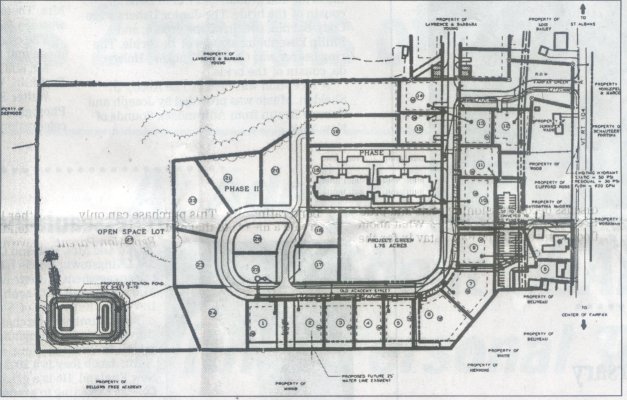FAIRFAX PROJECT GOES TO HEARING
GROWTH CENTER PROPOSAL'S ACT 250 RULING AWAITED
(This article appeared in the Saturday, September 13, 2003 issue of The St. Albans Messenger and was written by Lee J. Kahrs - Messenger Staff Writer

FAIRFAX-It has taken about three years, but a development plan for a 35-acre parcel in the designated growth center here has finally had its day before the District 6 Environmental Commission.
An Act 250 preliminary public hearing on the project was held at Bellows Free Academy, Fairfax Friday morning, following a site visit to the property.
Past problems regarding a town sewer expansion and clashes between the town treasurer and the selectboard, the Development Review Board, and the former zoning administrator and a group of community members (who want more controlled growth or no growth at all), have delayed the project for three years in an almost soap operatic atmosphere.
Those problems seem to have slowly disappeared over the last few months, finally clearing the way for the project to be presented before the commission.
Sam Ruggiano, of Cross Consulting Engineers of St. Albans, is the lead engineer on the project and made the presentation to the commission on behalf of John Workman and David Modica, who own the land. Workman and Modica also own and operate the Hayes-Rich Funeral Home on Route 104 in the center of Fairfax.
The parcel to be developed lies directly within the designated growth center of Fairfax. It is a primarily open field bordered on two sides by existing homes and on a third side by a wooded area. The land lies directly behind the Hayes and Rich Funeral Home. The development plan for the property is split into two phases.
Phase I entails the construction of 14 single-family lots and a 47-unit building designed for elderly housing with parking underneath.
Phase II would add 10 more single family lots, a village green, and a 61-space above ground parking lot. There also are discussions in the works to add a recreation path through the development.
Approximately 15 of the gs acres will remain open and undeveloped.
The main point of contention during the hearing Friday was the question of whether the property contains primary agricultural soils under Act 250 criteria 9B.
Marian White, policy analyst for the Vermont Department of Agriculture, Food and Markets, asked for party status and argued that the soil on the property meets the Act 250 criteria to be considered primary agricultural soil. White said because of this, steps should be taken to ensure that the land is treated with respect.
"Primary agricultural soils in Vermont are considered a valuable natural resource," she said. "I feel the impact on the soils would be significant."
White said her department would consider off-site mitigation - the conservation in perpetuity of agricultural soils located elsewhere - by the property owners as a trade-off for developing the land.
White said she does not necessarily believe the development project should be halted because of her argument.
"I'm not saying the land needs to be kept agricultural," she told the commission. "I'm just saying there are primary agricultural soils. "
Ruggiano argued that the soil cannot be considered prime agricultural soil because the land only meets three of the six Act 250 criteria necessary to be deemed prime agricultural.
He argued that the land becomes extremely wet and saturated in the spring' making it extremely difficult to use farm equipment on the property for farming purposes.
He also said that, because there is limited access to the property, it is impossible for large pieces of farm equipment to access the property in order to farm.
Raggiano also said the parcel is too small to farm and, at the same time, expect a reasonable fmancial return from the land.
He added that the owners of property bordering the current access to the property have said they do not want any agricultural activity on the land, particularly manure spreading, due to the smell and the disruptive nature of farm machinery traveling in and out of the area.
White has argued that, because Workman purchased a two~acre parcel in the northeast corner of the property to be developed, he now has adequate space for agricultural access to the property.
Workman told the commission that the land has not been farmed for about 30 years. He said he currently pays a local farmer to keep the land mowed, and even then the hay that is harvested is only good for bedding, not as food for livestock.
Workman also read from a letter sent to him by Gerald Minor, the man who sold him the additional two-acre parcel for access to the development project.
In the letter, Minor addresses a rumor that was spreading around Fairfax that Workman was going to use the property for agricultural purposes after all.
"I would very disappointed in you if the land was not developed and used for agricultural purposes," Minor wrote. "If I had known, I never would have sold you the property"
Minor sited dust and "unfavorable" odors as the reasons why he and other neighbors did not want the land to be farmed.
About a dozen local residents attended the hearing, which lasted about and hour and a half. No one spoke up during the public comment period at the end of the hearing. No entry of appearances for party status were filed by Fairfax residents prior to the hearing on Friday.
Having heard testimony the district commission is expected to make a decision within a matter of weeks.
Henry A. Raymond
vtgrandpa@yahoo.com
September 14, 2003

